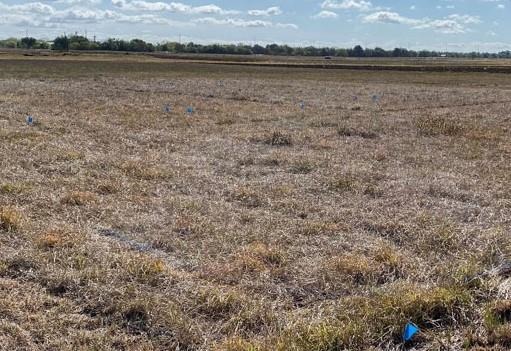By Bruno Pedreira and Dale Helwig
Farmers manage one million acres of tall fescue which are important forage sources for livestock production in Kansas. However, once in a while we end up facing weather conditions like the summer of 2022. Most of southeast Kansas was in D3 or D4 drought from late June through the fall. Because of the lack of rainfall, forage growth was very limited, and, in many operations, due to heavy grazing pressure and the low cutting height (if hayed), some of the fescue stands may have died or been extremely damaged (Figure 1).

Figure 1. Tall fescue field in October 2022 at Southeast Research and Extension Center.
In this scenario, there is not much to be done during the winter, but a plan is needed for the spring. In some places, after a few rainfall events in early fall, the fescue was greening up and looked to be in good condition, but in some places this is not the case and many producers are concerned.
Spring is not the ideal time to plant fescue as it takes time for the plant to develop a root system that will be able to withstand a dry period in the summer. Not that fescue cannot be planted in the spring, but management is critical. If planted in the spring, do not cut it for hay the first season, and be careful if it is grazed. If grazing, leave a minimum of 4 inches of stubble height and move the livestock around fairly quickly, giving the plant time to recover before the dry summer periods.
Assuming that time will tell whether the fescue is damaged or not, maybe the best plan would be to consider other forage options for spring and summer, and then replant the fescue in the fall when it is more suited for establishment.
Oats and warm-season annuals. Drilling oats into fescue pastures in February may be an option. Oats grow quickly and may be ready for grazing in late March or at least by mid-April. If the fescue is really damaged, oats may be a forage option for the livestock to graze or a crop that can be baled for hay. After grazing or haying the oats, some warm-season annuals (millet, sudan, etc.) can be seeded for summer hay or grazing.
Warm-season grasses. If fescue appears very damaged (maybe dead) next spring, this may be an opportunity to establish a warm-season grass such as crabgrass or bermuda. These grasses have a fairly quick establishment if a seeded variety is chosen. Then no-till fescue into the field next fall. Fescue and crabgrass work well together if managed correctly. In a recent trial carried out in Cherokee County, KS (2020 and 2021), crabgrass yielded from 1700 to 7600 lb. DM/acre during the growing season depending on fertilizer application. This will provide extended grazing throughout the year and will be a win in the long run.
Novel tall fescue. If you need to reseed the pasture, use this as an opportunity to make a positive change towards novel fescue using the spray-smother-spray method:
- Use a burndown herbicide such as glyphosate in early March.
- Plant a summer annual. Soybeans would allow one to control many types of unwanted grasses and weeds throughout the summer. Soybeans could be harvested as a cash crop (grain) or as high-quality hay. Other options are sudan, millet, crabgrass, or other summer annuals.
- Spray burndown herbicide in mid-August or early September and plant the novel fescue. In a grazing situation, novel fescue has shown to have a tremendous advantage over Kentucky-31 when it comes to cattle performance and weight gain.
Source : ksu.edu